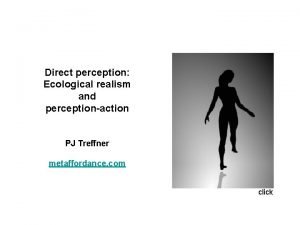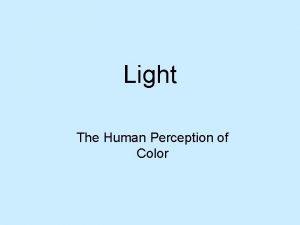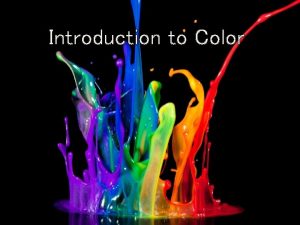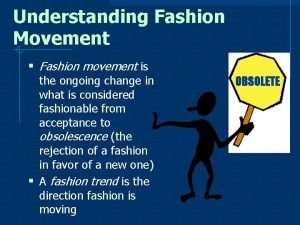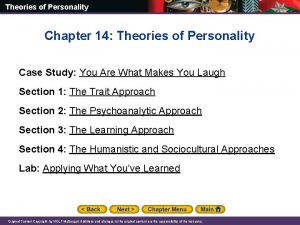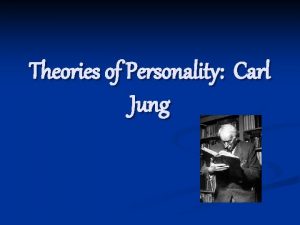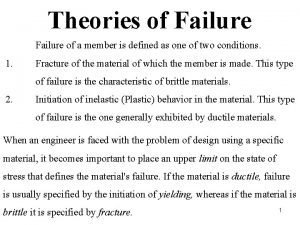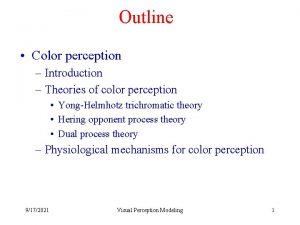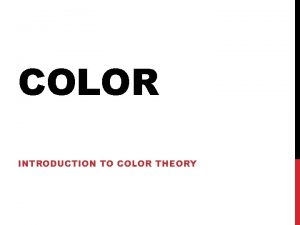Outline Color perception Introduction Theories of color perception































- Slides: 31

Outline • Color perception – Introduction – Theories of color perception • Yong-Helmhotz trichromatic theory • Hering opponent process theory • Dual process theory – Physiological mechanisms for color perception 11/5/2020 Visual Perception Modeling 1

Color Perception • The sensation of color is caused by the brain. • One way to get it is the response of the eye to the presence/absence of light at various wavelengths. 11/5/2020 Visual Perception Modeling 2

Physical description of light • Photon – A tiny packet of vibrating electro-magnetic energy – Characterized by the wavelength of its vibration – The photons we experience in visible light cover just a small portion of the electro-magnetic spectrum 11/5/2020 Visual Perception Modeling 3

Light Spectra 11/5/2020 Visual Perception Modeling 4

Physical description of light • Photon – A tiny packet of vibrating electro-magnetic energy – Characterized by the wavelength of its vibration – The photons we experience in visible light cover just a small portion of the electro-magnetic spectrum • Physical description of light – Number of photons it contains at each wavelength 11/5/2020 Visual Perception Modeling 5

Sunlight 11/5/2020 Visual Perception Modeling 6

Psychological description of color • Color space – The subjective experience of surface colors can be described in terms of three dimensions • Hue • Saturation • Lightness – Color space is the three-dimensional coordinate system in which each color experience is represented by a point 11/5/2020 Visual Perception Modeling 7

Psychophysical correspondence • Mapping between physical descriptions and psychological ones – Mean wavelength determines hue – Spectral area determines lightness • The total number of photons – Variance determines saturation 11/5/2020 Visual Perception Modeling 8

Basic Phenomena • Light mixture – Only a small portion of the colors correspond to monochromatic lights – Two or more colors must be combined in order to non-spectral colors and de-saturated colors – By experience, it is possible to match almost all colors using only three primary sources 11/5/2020 Visual Perception Modeling 9

Additive and subtractive matching • Choose colors A, B, C such that no two can be mixed to match the third - Primaries. • Many colors can be represented as a mixture of A, B, C write M=a A + b B + c C • This is additive matching. • Gives a color description system - two people who agree on A, B, C need only supply (a, b, c) to describe a color. 11/5/2020 • Some colors can’t be matched like this: instead, must write M+a A = b B+c C • This is subtractive matching. • Interpret this as (-a, b, c) • Problem for building monitors: Choose R, G, B such that positive linear combinations match a large set of colors Visual Perception Modeling 10

Some Phenomena • Color blindness – People who cannot discriminate among all the colors – There are several distinct varieties of color blindness • Color afterimages • Mach bands • Chromatic adaptation 11/5/2020 Visual Perception Modeling 11

Early theories and confusion • Widespread: We see things by rays fired out of the eyes, hitting surfaces; colors come from different kinds of rays. • Newton: Color is obtained by differential refraction of white light. • Artists: Can’t get enough colors from Newton; actually, color is obtained by mixing lights or pigments. 11/5/2020 Visual Perception Modeling 12

Young-Helmholtz Trichromatic Theory • Propose by Young-Helmholtz – There are three types of color receptors in the human eye – They were hypothesized to produce the psychologically primary color sensations of red, green, and blue – All other colors were explained as combinations of these primaries 11/5/2020 Visual Perception Modeling 13

Opponent Process Theory • Trichromatic theory cannot explain very well some facts and observations – Yellow is the additive mixture of red and green primaries but the subjective experience does not appear to be that way – Color experiences are always lost in certain pairs 11/5/2020 Visual Perception Modeling 14

Opponent Process Theory – cont. • Opponent process theory by Hering – There are four chromatic primaries rather than three – They are structured in pairs of polar opposites • Red/green • Blue/yellow • Black/write 11/5/2020 Visual Perception Modeling 15

Dual Process Theory • For many decades there were heated debates between two warring factions – Helmholtz vs. Hering • In 1957, Hurvich and Jameson proposed a dual processing theory Trichromatic theory 11/5/2020 Opponent-Process stage Visual Perception Modeling 16

Physiological Mechanisms • Three cone systems – There are three types of cones in the normal trichromat retina, each of which contains a different light-absorbing pigment – Absorption spectra of these three cone types are determined using different techniques 11/5/2020 Visual Perception Modeling 17

Color Receptors “Red” cone 11/5/2020 “Green” cone Visual Perception Modeling “Blue” cone 18

Color Opponent Cells • Color opponent cells in LGN – Responses in the LGN of moneys are roughly conformed to the pattern predicted by Hering’s opponent process theory – They are also found in the bipolar and ganglion cells in the retina 11/5/2020 Visual Perception Modeling 19

Theory for Color Perception • Trichromatic theory is perhaps the only theory that explains many perceptual phenomena nicely and in a unified framework • People have been trying to find theories in the other areas of perception – Texture perception 11/5/2020 Visual Perception Modeling 20

Representing Colors • Accurate color reproduction is commercially valuable - e. g. Kodak yellow, painting a house. • Of the order of 10 color names are widely recognized by English speakers - other languages have fewer/more, but not much more. • Color reproduction problems increased by prevalence of digital imaging – e. g. digital libraries of art. • Choosing pixel values to reproduce/evoke experiences, e. g. an architectural model. • Consistency in user interfaces, monitor-printer consistency, etc. 11/5/2020 Visual Perception Modeling 21

Color spaces • Linear color spaces describe colors as linear combinations of primaries – Choice of primaries • choice of color matching functions • choice of color space • RGB – primaries are monochromatic, energies are 645. 2 nm, 526. 3 nm, 444. 4 nm – Color matching functions have negative parts -> some colors can be matched only subtractively. • CIE XYZ – Color matching functions are positive everywhere, but primaries are imaginary 11/5/2020 Visual Perception Modeling 22

CIE x, y 11/5/2020 Visual Perception Modeling 23

Qualitative features of CIE x, y • Linearity implies that colors obtainable by mixing lights with colors A, B lie on line segment with endpoints at A and B • Monochromatic colors (spectral colors) run along the “Spectral Locus” • Dominant wavelength = Spectral color that can be mixed with white to match 11/5/2020 • Purity = (distance from C to spectral locus)/(distance from white to spectral locus) • Wavelength and purity can be used to specify color. • Complementary colors=colors that can be mixed with C to get white Visual Perception Modeling 24

More linear color spaces • Monitor RGB: primaries are monitor phosphor colors, primaries and color matching functions vary from monitor to monitor - careful! • YIQ: mainly used in television, Y is (approximately) intensity, I, Q are chromatic properties. Linear color space; hence there is a matrix M that transforms XYZ coords to YIQ coords. I and Q can be transmitted with low bandwidth. 11/5/2020 Visual Perception Modeling 25

Non-linear color spaces • HSV: Hue, Saturation, Value are non-linear functions of XYZ. – because hue relations are naturally expressed in a circle • Uniform: equal (small!) steps give the same perceived color changes. • Munsell: describes surfaces, rather than lights - less relevant for graphics. Surfaces must be viewed under fixed comparison light 11/5/2020 Visual Perception Modeling 26

Color books 11/5/2020 Visual Perception Modeling 27

Device independent color imaging • Problem: ensure that colors on a display, printer, etc. give the same experience that a viewer would have seeing relevant light spectra • Difficulty: limited gamuts of most output devices • Strategy: exploit a model of human experience 11/5/2020 Visual Perception Modeling 28

Constancy • We observe the color of • Lightness constancy the light reflected from – how light is the surface, independent of the surfaces brightness of the • But we want surface illuminant colour – problem is known as colour constancy – issues • spatial variation in illumination • absolute standard – Human lightness constancy is very good 11/5/2020 Visual Perception Modeling 29

Finding Skin Using Image Color • It is very useful to find human skin in images – Gesture-based user interfaces – Content-based retrieval – Ignore some pictures • A computational model of skin 11/5/2020 Visual Perception Modeling 30

Surface Color from Image Color • The color of light in an image is determined by two factors – Spectral reflectance of the surface – Spectral radiance of the light falling on that surface • Color of light falling surfaces can vary very widely – Image color can be a bad representation of the color of surfaces being viewed • Color constancy in human perception 11/5/2020 Visual Perception Modeling 31
 Projection
Projection Theories of perception
Theories of perception Example of quote sandwich
Example of quote sandwich An introduction to theories of learning
An introduction to theories of learning Classification of nursing theories
Classification of nursing theories Color perception examples
Color perception examples Conclusion paragraph outline
Conclusion paragraph outline Introduction paragraph outline
Introduction paragraph outline Software engineering 1 course outline
Software engineering 1 course outline Body paragraph
Body paragraph What is color
What is color Sociological theories of crime
Sociological theories of crime Site:slidetodoc.com
Site:slidetodoc.com Theories and values of positive practice
Theories and values of positive practice Hoyt and burgess model
Hoyt and burgess model Pass the proton acid-base theories answer key
Pass the proton acid-base theories answer key Classic fashion cycle
Classic fashion cycle Trait theories
Trait theories Trait theories
Trait theories Traditional learning theories
Traditional learning theories Action assembly theory public relations
Action assembly theory public relations What are the theories of poverty
What are the theories of poverty What does the psychoanalytic approach to personality teach?
What does the psychoanalytic approach to personality teach? Psychic inheritance jung
Psychic inheritance jung Matrix vesicle theory of mineralization
Matrix vesicle theory of mineralization Theories of justice
Theories of justice Human rights theory
Human rights theory Downward flow theory fashion
Downward flow theory fashion Distortion energy theory formula
Distortion energy theory formula Modern biological theories of crime
Modern biological theories of crime Feminist therapy ppt
Feminist therapy ppt Developmental stage theory
Developmental stage theory

